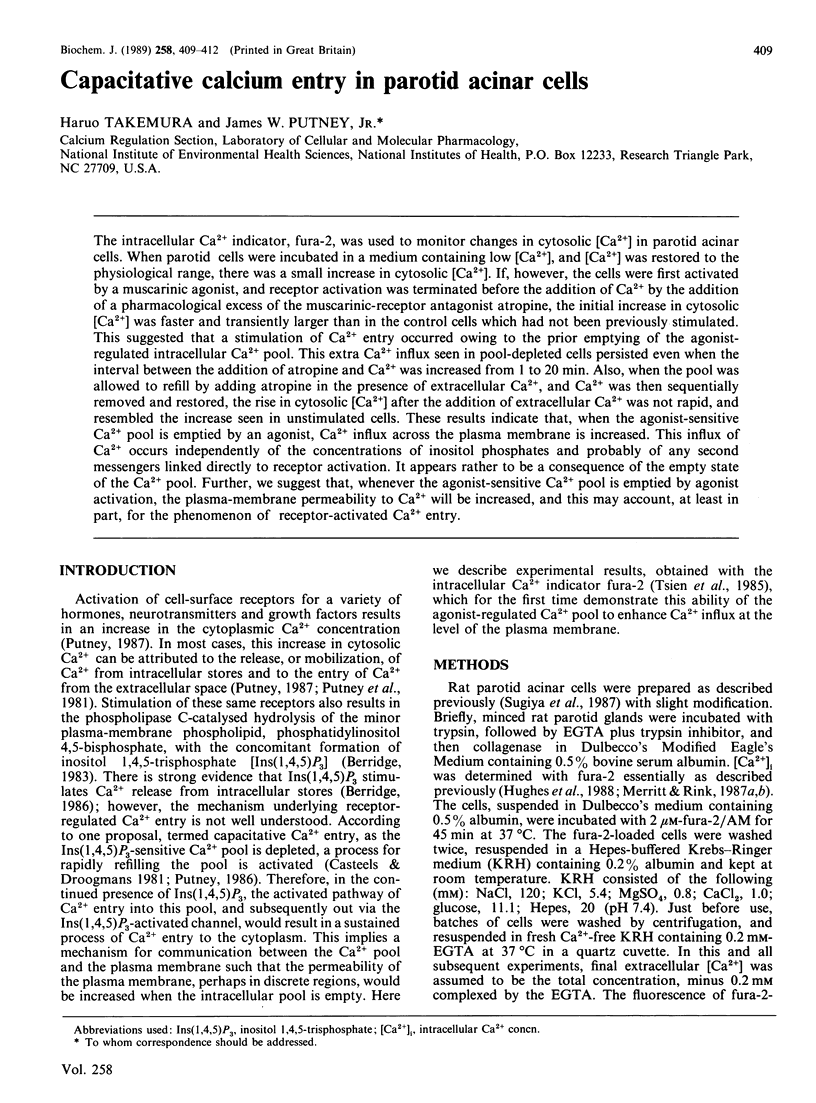Abstract
The intracellular Ca2+ indicator, fura-2, was used to monitor changes in cytosolic [Ca2+] in parotid acinar cells. When parotid cells were incubated in a medium containing low [Ca2+], and [Ca2+] was restored to the physiological range, there was a small increase in cytosolic [Ca2+]. If, however, the cells were first activated by a muscarinic agonist, and receptor activation was terminated before the addition of Ca2+ by the addition of a pharmacological excess of the muscarinic-receptor antagonist atropine, the initial increase in cytosolic [Ca2+] was faster and transiently larger than in the control cells which had not been previously stimulated. This suggested that a stimulation of Ca2+ entry occurred owing to the prior emptying of the agonist-regulated intracellular Ca2+ pool. This extra Ca2+ influx seen in pool-depleted cells persisted even when the interval between the addition of atropine and Ca2+ was increased from 1 to 20 min. Also, when the pool was allowed to refill by adding atropine in the presence of extracellular Ca2+, and Ca2+ was then sequentially removed and restored, the rise in cytosolic [Ca2+] after the addition of extracellular Ca2+ was not rapid, and resembled the increase seen in unstimulated cells. These results indicate that, when the agonist-sensitive Ca2+ pool is emptied by an agonist, Ca2+ influx across the plasma membrane is increased. This influx of Ca2+ occurs independently of the concentrations of inositol phosphates and probably of any second messengers linked directly to receptor activation. It appears rather to be a consequence of the empty state of the Ca2+ pool. Further, we suggest that, whenever the agonist-sensitive Ca2+ pool is emptied by agonist activation, the plasma-membrane permeability to Ca2+ will be increased, and this may account, at least in part, for the phenomenon of receptor-activated Ca2+ entry.
Full text
PDF



Selected References
These references are in PubMed. This may not be the complete list of references from this article.
- Aub D. L., McKinney J. S., Putney J. W., Jr Nature of the receptor-regulated calcium pool in the rat parotid gland. J Physiol. 1982 Oct;331:557–565. doi: 10.1113/jphysiol.1982.sp014391. [DOI] [PMC free article] [PubMed] [Google Scholar]
- Berridge M. J. Rapid accumulation of inositol trisphosphate reveals that agonists hydrolyse polyphosphoinositides instead of phosphatidylinositol. Biochem J. 1983 Jun 15;212(3):849–858. doi: 10.1042/bj2120849. [DOI] [PMC free article] [PubMed] [Google Scholar]
- Casteels R., Droogmans G. Exchange characteristics of the noradrenaline-sensitive calcium store in vascular smooth muscle cells or rabbit ear artery. J Physiol. 1981 Aug;317:263–279. doi: 10.1113/jphysiol.1981.sp013824. [DOI] [PMC free article] [PubMed] [Google Scholar]
- Grynkiewicz G., Poenie M., Tsien R. Y. A new generation of Ca2+ indicators with greatly improved fluorescence properties. J Biol Chem. 1985 Mar 25;260(6):3440–3450. [PubMed] [Google Scholar]
- Guillemette G., Balla T., Baukal A. J., Catt K. J. Characterization of inositol 1,4,5-trisphosphate receptors and calcium mobilization in a hepatic plasma membrane fraction. J Biol Chem. 1988 Apr 5;263(10):4541–4548. [PubMed] [Google Scholar]
- Hughes A. R., Takemura H., Putney J. W., Jr Kinetics of inositol 1,4,5-trisphosphate and inositol cyclic 1:2,4,5-trisphosphate metabolism in intact rat parotid acinar cells. Relationship to calcium signalling. J Biol Chem. 1988 Jul 25;263(21):10314–10319. [PubMed] [Google Scholar]
- Irvine R. F., Letcher A. J., Lander D. J., Berridge M. J. Specificity of inositol phosphate-stimulated Ca2+ mobilization from Swiss-mouse 3T3 cells. Biochem J. 1986 Nov 15;240(1):301–304. doi: 10.1042/bj2400301. [DOI] [PMC free article] [PubMed] [Google Scholar]
- Merritt J. E., Rink T. J. Regulation of cytosolic free calcium in fura-2-loaded rat parotid acinar cells. J Biol Chem. 1987 Dec 25;262(36):17362–17369. [PubMed] [Google Scholar]
- Merritt J. E., Rink T. J. The effects of substance P and carbachol on inositol tris- and tetrakisphosphate formation and cytosolic free calcium in rat parotid acinar cells. A correlation between inositol phosphate levels and calcium entry. J Biol Chem. 1987 Nov 5;262(31):14912–14916. [PubMed] [Google Scholar]
- Morris A. P., Gallacher D. V., Irvine R. F., Petersen O. H. Synergism of inositol trisphosphate and tetrakisphosphate in activating Ca2+-dependent K+ channels. Nature. 1987 Dec 17;330(6149):653–655. doi: 10.1038/330653a0. [DOI] [PubMed] [Google Scholar]
- Poggioli J., Mauger J. P., Guesdon F., Claret M. A regulatory calcium-binding site for calcium channel in isolated rat hepatocytes. J Biol Chem. 1985 Mar 25;260(6):3289–3294. [PubMed] [Google Scholar]
- Putney J. W., Jr A model for receptor-regulated calcium entry. Cell Calcium. 1986 Feb;7(1):1–12. doi: 10.1016/0143-4160(86)90026-6. [DOI] [PubMed] [Google Scholar]
- Putney J. W., Jr, Poggioli J., Weiss S. J. Receptor regulation of calcium release and calcium permeability in parotid gland cells. Philos Trans R Soc Lond B Biol Sci. 1981 Dec 18;296(1080):37–45. doi: 10.1098/rstb.1981.0169. [DOI] [PubMed] [Google Scholar]
- Sugiya H., Tennes K. A., Putney J. W., Jr Homologous desensitization of substance-P-induced inositol polyphosphate formation in rat parotid acinar cells. Biochem J. 1987 Jun 15;244(3):647–653. doi: 10.1042/bj2440647. [DOI] [PMC free article] [PubMed] [Google Scholar]
- Tsien R. Y., Rink T. J., Poenie M. Measurement of cytosolic free Ca2+ in individual small cells using fluorescence microscopy with dual excitation wavelengths. Cell Calcium. 1985 Apr;6(1-2):145–157. doi: 10.1016/0143-4160(85)90041-7. [DOI] [PubMed] [Google Scholar]
- Wilson D. B., Connolly T. M., Bross T. E., Majerus P. W., Sherman W. R., Tyler A. N., Rubin L. J., Brown J. E. Isolation and characterization of the inositol cyclic phosphate products of polyphosphoinositide cleavage by phospholipase C. Physiological effects in permeabilized platelets and Limulus photoreceptor cells. J Biol Chem. 1985 Nov 5;260(25):13496–13501. [PubMed] [Google Scholar]


